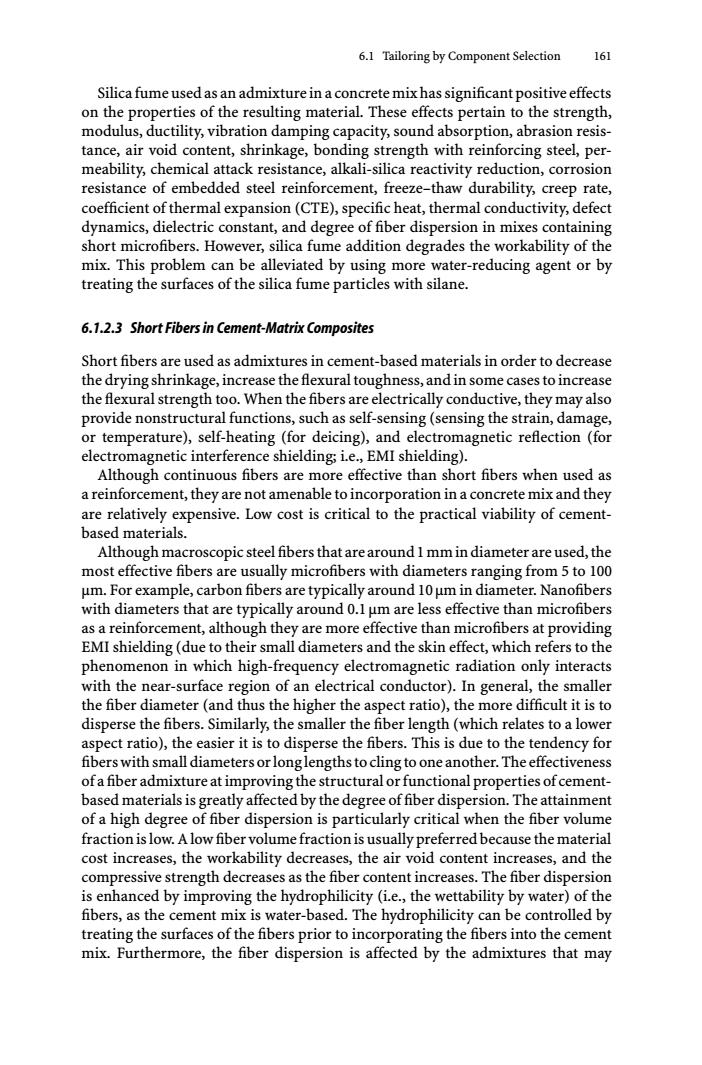正在加载图片...

6.1 Tailoring by Component Selection 161 Silica fume used as an admixture in a concrete mix has significant positive effects on the properties of the resulting material.These effects pertain to the strength, modulus,ductility,vibration damping capacity,sound absorption,abrasion resis- tance,air void content,shrinkage,bonding strength with reinforcing steel,per- meability,chemical attack resistance,alkali-silica reactivity reduction,corrosion resistance of embedded steel reinforcement,freeze-thaw durability,creep rate, coefficient of thermal expansion(CTE),specific heat,thermal conductivity,defect dynamics,dielectric constant,and degree of fiber dispersion in mixes containing short microfibers.However,silica fume addition degrades the workability of the mix.This problem can be alleviated by using more water-reducing agent or by treating the surfaces of the silica fume particles with silane. 6.1.2.3 Short Fibers in Cement-Matrix Composites Short fibers are used as admixtures in cement-based materials in order to decrease the drying shrinkage,increase the flexural toughness,and in some cases to increase the flexural strength too.When the fibers are electrically conductive,they may also provide nonstructural functions,such as self-sensing(sensing the strain,damage, or temperature),self-heating (for deicing),and electromagnetic reflection (for electromagnetic interference shielding;i.e.,EMI shielding). Although continuous fibers are more effective than short fibers when used as a reinforcement,they are not amenable to incorporation in a concrete mix and they are relatively expensive.Low cost is critical to the practical viability of cement- based materials. Although macroscopic steel fibers that are around 1 mm in diameter are used,the most effective fibers are usually microfibers with diameters ranging from 5 to 100 um.For example,carbon fibers are typically around 10 um in diameter.Nanofibers with diameters that are typically around 0.1 um are less effective than microfibers as a reinforcement,although they are more effective than microfibers at providing EMI shielding(due to their small diameters and the skin effect,which refers to the phenomenon in which high-frequency electromagnetic radiation only interacts with the near-surface region of an electrical conductor).In general,the smaller the fiber diameter(and thus the higher the aspect ratio),the more difficult it is to disperse the fibers.Similarly,the smaller the fiber length(which relates to a lower aspect ratio),the easier it is to disperse the fibers.This is due to the tendency for fibers with small diameters or longlengths to cling to one another.The effectiveness of a fiber admixture at improving the structural or functional properties of cement- based materials is greatly affected by the degree of fiber dispersion.The attainment of a high degree of fiber dispersion is particularly critical when the fiber volume fraction is low.A low fiber volume fraction is usually preferred because the material cost increases,the workability decreases,the air void content increases,and the compressive strength decreases as the fiber content increases.The fiber dispersion is enhanced by improving the hydrophilicity(i.e.,the wettability by water)of the fibers,as the cement mix is water-based.The hydrophilicity can be controlled by treating the surfaces of the fibers prior to incorporating the fibers into the cement mix.Furthermore,the fiber dispersion is affected by the admixtures that may6.1 Tailoring by Component Selection 161 Silica fume used as an admixture in a concrete mix has significant positive effects on the properties of the resulting material. These effects pertain to the strength, modulus, ductility, vibration damping capacity, sound absorption, abrasion resistance, air void content, shrinkage, bonding strength with reinforcing steel, permeability, chemical attack resistance, alkali-silica reactivity reduction, corrosion resistance of embedded steel reinforcement, freeze–thaw durability, creep rate, coefficient of thermal expansion (CTE), specific heat, thermal conductivity, defect dynamics, dielectric constant, and degree of fiber dispersion in mixes containing short microfibers. However, silica fume addition degrades the workability of the mix. This problem can be alleviated by using more water-reducing agent or by treating the surfaces of the silica fume particles with silane. 6.1.2.3 Short Fibers in Cement-Matrix Composites Short fibers are used as admixtures in cement-based materials in order to decrease the drying shrinkage, increase the flexural toughness, and in some cases to increase the flexural strength too. When the fibers are electrically conductive, they may also provide nonstructural functions, such as self-sensing (sensing the strain, damage, or temperature), self-heating (for deicing), and electromagnetic reflection (for electromagnetic interference shielding; i.e., EMI shielding). Although continuous fibers are more effective than short fibers when used as a reinforcement, they are not amenable to incorporation in a concrete mix and they are relatively expensive. Low cost is critical to the practical viability of cementbased materials. Although macroscopic steelfibersthat arearound1mmindiameter areused,the most effective fibers are usually microfibers with diameters ranging from 5 to 100 μm. For example, carbon fibers are typically around 10μm in diameter. Nanofibers with diameters that are typically around 0.1μm are less effective than microfibers as a reinforcement, although they are more effective than microfibers at providing EMI shielding (due to their small diameters and the skin effect, which refers to the phenomenon in which high-frequency electromagnetic radiation only interacts with the near-surface region of an electrical conductor). In general, the smaller the fiber diameter (and thus the higher the aspect ratio), the more difficult it is to disperse the fibers. Similarly, the smaller the fiber length (which relates to a lower aspect ratio), the easier it is to disperse the fibers. This is due to the tendency for fiberswithsmalldiametersorlonglengthstoclingtooneanother.Theeffectiveness of a fiber admixture at improving the structural or functional properties of cementbased materials is greatly affected by the degree of fiber dispersion. The attainment of a high degree of fiber dispersion is particularly critical when the fiber volume fraction is low. A low fiber volume fraction is usually preferred because the material cost increases, the workability decreases, the air void content increases, and the compressive strength decreases as the fiber content increases. The fiber dispersion is enhanced by improving the hydrophilicity (i.e., the wettability by water) of the fibers, as the cement mix is water-based. The hydrophilicity can be controlled by treating the surfaces of the fibers prior to incorporating the fibers into the cement mix. Furthermore, the fiber dispersion is affected by the admixtures that may